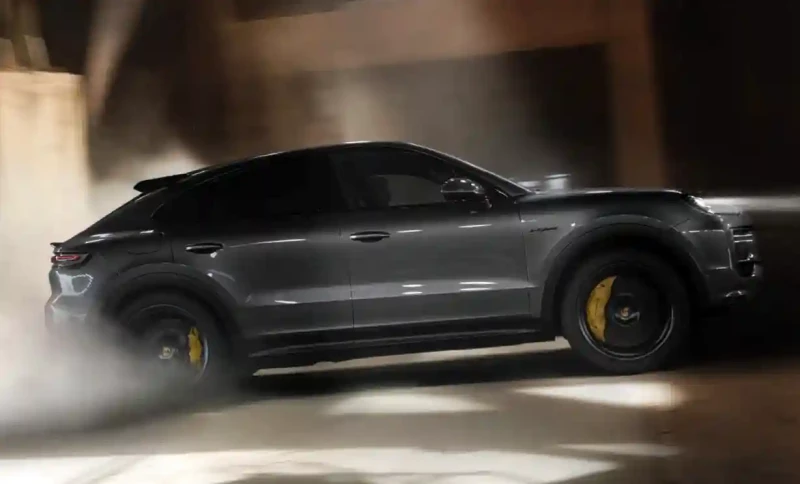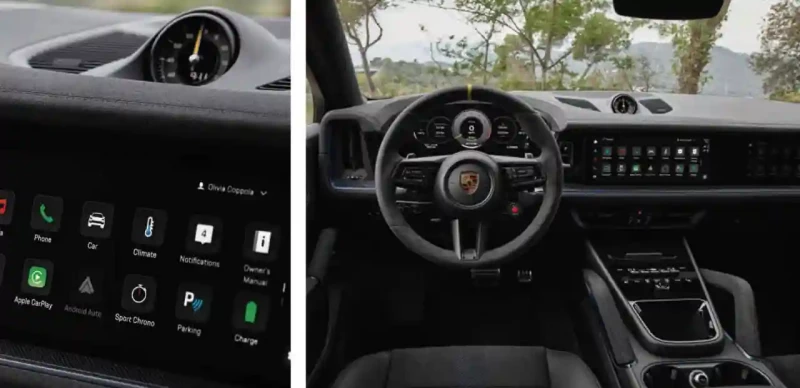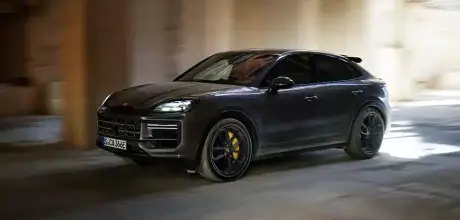2024 Porsche Cayenne Turbo E-Hybrid Coupe with GT Package (PHEV) 9Y3
The clumsily named Cayenne Turbo E-Hybrid Coupe with GT Package is one of the most powerful road cars Porsche has ever built. This super-SUV attempts to recreate the Cayenne Turbo GT’s magic, but in plug-in hybrid form. Has the novel approach worked?
Words Matt Robinson
Photography Andreas Koslowski
THE POINT OF DEPARTURE
Why does GT, an innocuouslooking pairing of letters, get Porsche fans so hot under the collar? After all, GT is widely used by all manner of automotive manufacturers and on all sorts of products. In the wider scheme of things, GT stands for gran turismo, which is the Italian way of saying grand tourer. And yet, whenever these two letters are appended to a Stuttgart-crested sports car, we go weak at the knees. Add RS nomenclature to get us even more excited.

If you want incontrovertible evidence of GT’s power in the Porsche fold, look no further than the Cayenne sports utility vehicle. Nobody could have expected quite what the company’s GT division would serve up when it allowed its cypher to be planted on the biggest, heaviest vehicle Porsche produces, but in 2021, the Cayenne Turbo GT arrived. It completely rewrote the rules of what an SUV ought to be capable of.
Okay, we’re being slightly disingenuous here — the Cayenne Turbo GT obviously had significant development input from Porsche’s GT division, but it wasn’t one of the department’s glittering pieces of coursework. That said, to put GT badging on the back of a two-tonne-plus SUV was a daring decision. Thankfully, it paid off handsomely.
There are some truly great-handling performance-oriented SUVs out in the world. Manufacturers have embraced the myriad clever technologies required to make such inherently cumbersome vehicles handle sharply and, crucially, in an involving manner. Porsche is one of the leading lights, of course — the Cayenne and Macan are benchmarks in their respective fields, regardless of the drivetrain a particular model possesses. The Turbo GT was something else, though. Here was a lighter, more focused version of the Cayenne Turbo Coupe. The Turbo GT delivered a genuine downforce-generating spoiler perched atop the rear screen and offered a healthy power boost to help the big brute along the road. It is, perhaps, a touch controversial to suggest a 2,220kg super-SUV nearly five metres long, two metres wide and more than 1.6 metres tall can in any way be considered a sports vehicle, but this is exactly what the Turbo GT is.

It is also utterly sublime to drive — the Turbo GT’s beautifully informative steering and majestic front-end ensures effortless changes of direction, keeping the vehicle’s body flat, even under the greatest mid-corner provocation and when every last one of 631 horses is unleashed by the phenomenally charismatic, twinturbocharged four-litre V8. Never mind considering the merits of other SUVs — when we had the Turbo GT on test for an extended period, we reasoned few sports cars of any description were as good as or as enjoyable to drive. The ultimate Cayenne, then?
Sadly, tightening of emissions regulations mean the Turbo GT can no longer be sold new anywhere in Europe, although it continues to be offered in North American Porsche main dealer showrooms and select other markets, although for how long? The standard Cayenne Turbo has been chopped for the same reason. All is not lost: the four-litre twin-turbocharged V8 under Turbo and Turbo GT bonnets lives on in the facelifted third-generation Cayenne line-up, albeit with the emissionsslashing assistance of plug-in hybrid electric vehicle (PHEV) technology.

With the Stuttgart concern’s largest model available in regular SUV body style or the more racylooking Coupe (one of the bestlooking coupe- SUVs going at any level), you’ve got five main choices of drivetrain. Sixty percent of them, regardless of body style, are PHEVs marketed under Porsche’s now familiar E-Hybrid banner. Porsche offered two E-Hybrids in the pre-facelift line-up of the Cayenne 9YA/ YB generation. Their replacements are, in essence, carry-overs. Whereas the entry-level E-Hybrid continues (albeit marginally uprated for power at the cost of a dab of torque, illustrated by the hike from 456bhp to 464bhp, but down to 480lb-ft from peak of 516lb-ft), the old Turbo S E-Hybrid (671bhp and 664lb-ft torque) has been superseded by the new Turbo E-Hybrid, which doesn’t look like much like an upgrade, given the loss of the S badging. Even so, it forms the starting point for the GT Package.
What we’ve not yet mentioned is the all-new 512bhp Cayenne S E-Hybrid. We’ll bring you a full review, as well as our verdict on the ‘plain’ Turbo E-Hybrid, in forthcoming issues of 911 & Porsche World. What we’re focusing on here, then, is the clunkily named Cayenne Turbo E-Hybrid Coupe with GT Package.
It uses the Turbo E-Hybrid as its source, but doesn’t add any extra power. Then again, why would the GT Package need it? Believe it or not, there has been only one road-going production Porsche powered by an internal combustion engine with higher bhp than the new flagship Cayenne: 2013’s astonishing 918 Spyder. You’ll recall this was a PHEV to boot.
Yes, somewhat outrageously, what you’re looking at with any Cayenne Turbo E-Hybrid is a system offering maximum power output on the far side of 700bhp. A jaw-dropping 729bhp, in fact. At 701lbft, the torque to go with it is equally monstrous. Performance is, as you would expect, exceptional. Specifically, the dash to 62mph from a standing start takes just 3.7 seconds. Top speed is 183mph. Consider the Turbo E-Hybrid Coupe tips scales at a chunky 2,670kg. In its seventy-five-year-plus history, Porsche hasn’t made a road-going vehicle so heavy. This is a company whose name appeared on tractors in the 1950s, don’t forget.
This is where the GT Package comes in. Effectively, it strips out weight. Only available with the Coupe body style, it takes a significant hundred kilograms from the kerb weight of the Turbo E-Hybrid Coupe through a raft of measures, including replacing the standard-fit panoramic glass roof with a carbon-fibre panel. Porsche Ceramic Composite Brakes (PCCB) feature, as does a lithium-ion twelve-volt battery in place of the usual lead-acid affair.
Bringing us back to our opening gambit, this Cayenne doesn’t half look familiar to anyone lusting after the now departed Turbo GT. The Turbo E-Hybrid with GT Package not only has the same carbon-fibre roof and PCCB kit, but also has the aforementioned fixed spoiler at the top of its rear screen, complementing the automatically operated spoiler the Coupe’s hatch. The same attractive twenty-two-inch alloy wheels (which can be painted in colours contrasting the body and to match a bold set of stripes along the bottom of the doors) are also present. Additionally, the Turbo E-Hybrid with GT Package boasts the Turbo GT’s two central oval exhaust pipes, as well as pipework constructed from titanium. In short, this is the only way Porsche can continue selling the Turbo GT in markets the model has been outlawed. In our earlier review of this controversial Cayenne, we applauded the four-litre V8, the model’s strident styling and its focus on driving thrills above all other considerations, which was especially welcome in an age demanding exhaust emissions are cut further. With this in mind, we inevitably end up comparing the Turbo E-Hybrid Coupe with GT Package with the Turbo GT. What we conclude, regrettably, is less than flattering to the newbie.
In the game of statistical Top Trumps, the PHEV has significant advantages on power (98bhp) and torque (74lb-ft), but the telling number is the time it takes to race from rest to 62mph. While the GT Package’s lower kerb weight trims a tenth from the standard Turbo E-Hybrid’s record in the same test, 3.6 seconds pales in comparison to the Turbo GT’s fiery 3.3-second abilities. This comes down to bulk. Despite the weight-saving measures we’ve namechecked, the Turbo E-Hybrid with GT Package is 275 kilograms heavier than the Turbo GT. A considerable sum.
The weight of a sizable motorcycle, in fact. Presumably, this is why Porsche chose to name this flavour of Cayenne the Turbo E-Hybrid Coupe with GT Package, rather than simply referring to it as the Turbo E-Hybrid GT. An important distinction of nomenclature is at play. Much of what the GT Package does, of course, is magnificent. This Porsche is blessed with some of the best steering you’ll find in the modern age, irrespective of whether the host vehicle is an SUV. And with its mammoth roadroller rubber, there’s grip for years. Yet, when the tyres do let go, the Turbo E-Hybrid Coupe with GT Package feels the most playful and faithfully adjustable of the entire Cayenne PHEV range. It also limits body roll, pitch and dive beautifully, which is impressive, considering the forces required to keep the significant mass in check.
On a track, this is a mighty impressive Porsche. On roads, it has the added advantage of being able to travel a claimed forty-five miles on electric power alone, enhancing a refinement level we acknowledge as top-notch, not least on account of new twovalve Porsche Active Suspension Management (PASM) dampers. These have dedicated valves for each of rebound and compression, rather than the previous set-up, where one valve did both jobs. The upshot is an extra polish of sophistication for ride comfort and rolling refinement.
Unsurprisingly, you’re unlikely to get forty-five miles on purely electric power for all but the most conservative of journeys, just as you probably won’t achieve Porsche’s frankly preposterous 148.7mpg combined economy figure. Reckon on sub-10mpg if you batter the drivetrain hard for an extended period, such as on track or a challenging road. We know this because the Cayenne Turbo E-Hybrid returned 7.7mpg on one of our mountain test routes.
The Turbo E-Hybrid with GT Package is all things to all people. It can be a demented back-road charger or remarkably talented on-track machine one minute, and a saintly EV-alike in urban areas the next. In accordance with the rest of the updated Cayenne range, there’s a beautiful cabin and decent practicality. The updated interior delivers a 12.6-inch digital instrument cluster with no cowl, as you’d find in a Taycan. You also get the option of a 10.9-inch front passenger display screen. On the outside resides slimmer headlamp units, a bolder tailgate strip (between the rear clusters), discreetly adjusted bumpers, revised front wings and an updated bonnet. All in, this is an amazingly cohesive, deeply talented Porsche. It’s a marvel of modern engineering, too.
The problem is the use of those two little letters, GT. Starting at £154,000, the GT Package is an expensive £21,400 uplift on the 729bhp Turbo E-Hybrid Coupe. As good as the GT Package is dynamically, it never reaches the giddy kinematic heights of the deposed Turbo GT. There’s also the huge elephant in the room: just how good will the Turbo E-Hybrid with GT Package be to drive with a long-depleted battery pack. In this scenario, the 591bhp four-litre V8 is essentially having to haul around 275kg of ballast.
Not even the addition of Package after those hallowed initials can detract from the fact that, as superbly talented as the Turbo E-Hybrid with GT Package undoubtedly is, and notwithstanding it being the most enjoyable drive of the entire updated Cayenne E-Hybrid range, it is nevertheless far from the best Cayenne manufactured to date. This honour remains with the Turbo GT, a supposedly outmoded model wearing those hallowed two letters with unmatched distinction.
Above Yellow calipers highlight the presence of Porsche Ceramic Composite Brakes (PCCB), needed to act as a foil to massive power output. Below Cayenne Turbo E-Hybrid and Cayenne Turbo E-Hybrid Coupe with GT-Package pictured side-by-side.
THE TURBO E-HYBRID COUPE WITH GT PACKAGE FEELS THE MOST PLAYFUL AND FAITHFULLY ADJUSTABLE OF THE ENTIRE CAYENNE PHEV RANGE
Above and right Passenger gets their own standalone infotainment screen, which is invisible to the driver thanks to a meshed screen cover.

Above and below Cayenne Coupe body styling sacrifices a bit of headroom in the back and slightly reduces luggage capacity over the standard SUV body style, but amazing looks make the tradeoff more than worth it.
TECH SPEC
- Model 2024 Porsche Cayenne Turbo E-Hybrid Coupe with GT Package (PHEV) 9Y3
- Engine EA825TT 3,996cc ‘hot inside-V’ biturbo V8 petrol, plus 130kW electric motor and 25.9kWh lithium-ion battery pack
- Petrol 591bhp at 6,000rpm, electric 174bhp at 3,200rpm, system maximum 729bhp at 5,500-6,800rpm
- Transmission Tiptronic S eight-speed torque-converter semi-automatic gearbox, Porsche Traction Management, all-wheel drive
- Economy 148.7mpg (combined)
- CO2 emissions 40-43g/km
- Top speed 189mph hybrid mode, 84mph electric mode
- Acceleration 0-62mph 3.6 seconds
- Max Power Petrol 590lb-ft at 2,400-4,500rpm, electric 332lb-ft at
- Max Torque Petrol 590lb-ft at 2,400-4,500rpm, electric 332lb-ft at 0-2,690rpm, system maximum 701lb-ft at 900-5,130rpm
- Weight 2,495kg (DIN), 2,570kg (EU)
- Dimensions 4,930mm long, 1,995mm wide (excluding mirrors), 1,652mm high, 2,895mm wheelbase
- Price From £154,000
THIS IS THE ONLY WAY PORSCHE CAN CONTINUE SELLING THE TURBO GT IN MARKETS THE MODEL HAS BEEN OUTLAWED
Above Interior is a neat mix of carbonfibre, Alcantara and digital displays, although we’re not fans of the entirely digital instrument cluster, mirroring that of the Taycan Below Just your everyday school run.

Above Utilising the might of the four-litre V8 in combination with the potent electric motor results in a massive 729bhp and 701lb-ft torque.


